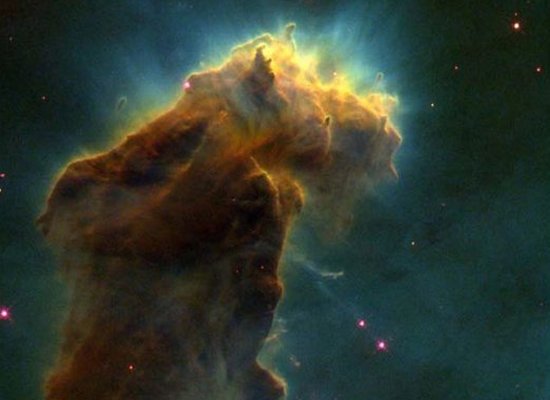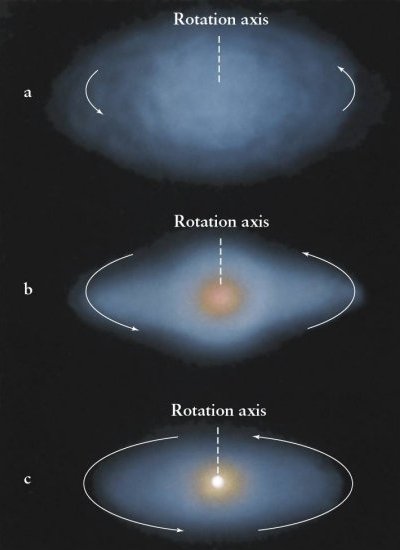Do the planets and moons in our solar system tend to orbit and rotate in the same plane? If so, what would be the cause of such uniformity? Why do all the planets orbit the Sun in the same direction?
Yes, the planets and most other large bodies of the solar system do orbit the Sun in about the same plane. This plane that contains the orbits of most of the planets, moons, and asteroids is called the ecliptic plane. When viewed from overhead, the planets also rotate about the Sun in the same counter-clockwise direction. Most moons also rotate around their parent planets in this same direction. The reason for these behaviors relates to how the solar system was formed some 4.6 billion years ago. Bear in mind that the explanation we are about to discuss is only a theory that appears to explain the structure of the solar system as scientists currently understand it. As astronomers learn more about our own solar system as well as the planets orbiting other stars in the galaxy, it is very possible that this theory may change and evolve.

Planets of the solar system (not to scale)
The leading hypothesis to explain how the solar system formed is called the condensation theory, which is based on a related explanation called the nebular theory. A nebula is a large cloud of gas and dust that exists in the depths of interstellar space. These clouds typically form during the death of a giant star when it goes supernova. This mighty explosion sends most of the star's mass outward into space as a massive wave of debris. The nebular cloud from which our solar system formed may have accumulated from one or more stars that went supernova billions of years ago. Astronomers have used the Hubble Space Telescope and other observatories to discover similar nebular clouds where new stars and possibly planets appear to be in the process of being created.

Stars forming in small protrusions from the Eagle Nebula
Astronomers estimate that the nebular cloud from which our solar system formed contained about two to three times the mass of the Sun and was about 100 astronomical units (AU) across. An astronomical unit is defined as the average distance between the Sun and Earth, or about 93 million miles (150 million km). This massive loosely-bound cloud of dust, ice particles, and gases (primarily hydrogen and helium) had some small rate of rotation due to the method in which it was formed. Over time, this nebular cloud began to collapse inward. The collapse may have itself been triggered by a supernova that sent shockwaves through the cloud causing it to compress. As the cloud compressed on itself, the gravitational attraction of the matter within increased and pulled the material in even further. The nebula continued to contract under the influence of gravity causing it to spin faster. The more the cloud contracted, the faster it rotated due to the conservation of angular momentum. The rate of contraction was greatest near the center of the cloud where a dense central core began to form. As the rate of rotation of the nebula continued to increase, centrifugal effects caused the spinning cloud to flatten into a disk with a bulge at its center.

Contracting nebular cloud increasing its rate of rotation
The middle of this spinning disk further condensed to eventually form the Sun at the center of the solar system. The material spinning around this new star also condensed into several large chunks of material called planetoids. As these planetoids collided, they coallesced into larger bodies to form the planets that exist today. Because the Sun and planets all formed from the same nebular cloud, they all rotate in the same direction that was induced on the disk of material as it coallesced. Not only do the planets all rotate counter-clockwise around the Sun, but the Sun and nearly all the planets rotate counter-clockwise about their axes. The solar equator and the plane containing the orbits of the planets are also nearly identical, further supporting the formation theory described above.

Spinning cloud flattening into a disk and condensing into a star and planets
Only a few exceptions to this explanation can be found in the solar system. The planet Venus actually rotates clockwise around its axis in what is called a retrograde motion. Uranus is also in an unusual orientation since the world is tilted on its side with its north and south poles in about the same plane as the planet's orbit around the Sun. Tiny Pluto is also tilted on its side and is the only planet with an orbit considerably outside of the ecliptic plane. While the reasons for these eccentricities are unknown, it is believed that large collisions with other large bodies during the formation of the solar system may account for the unusual characteristics of these planets.
No comments:
Post a Comment